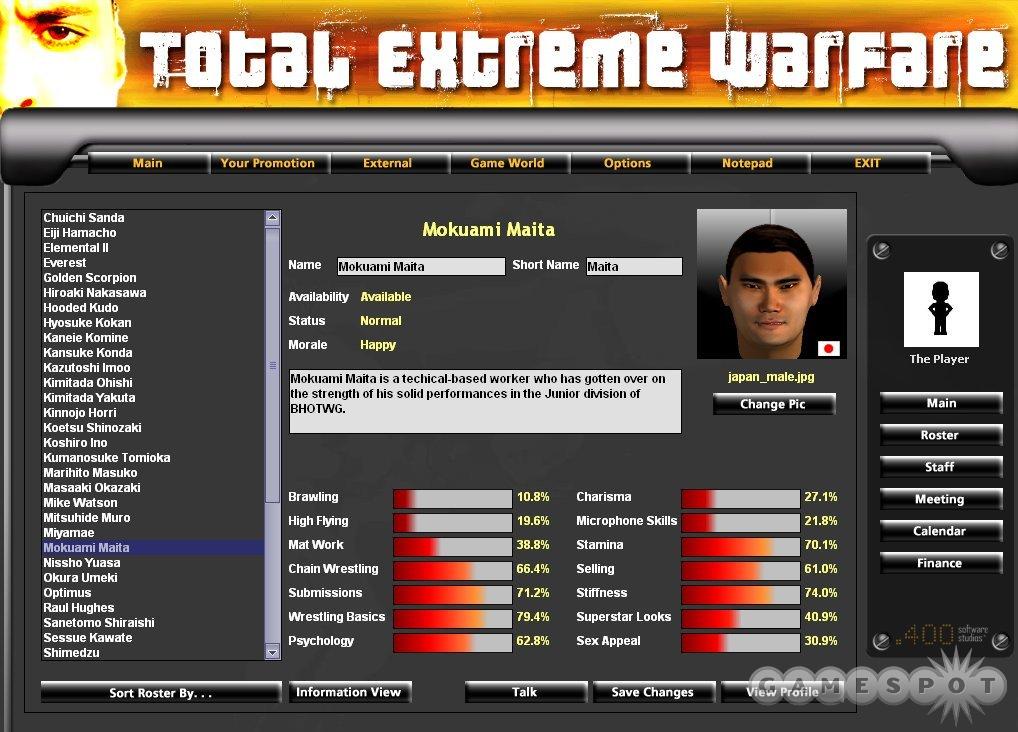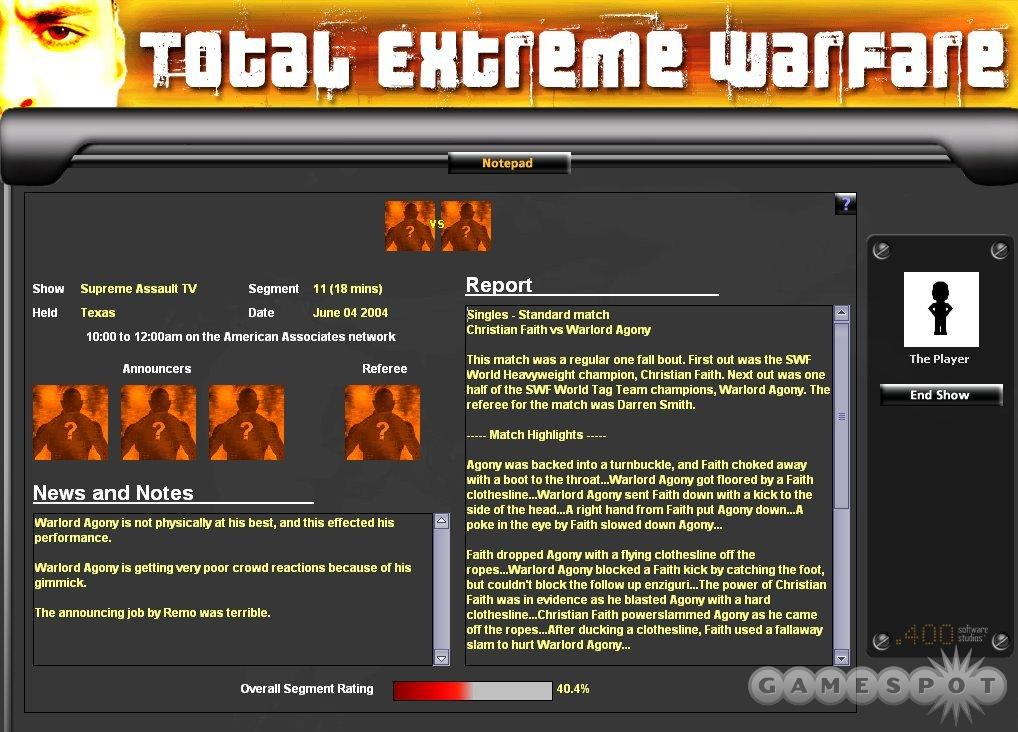Esoteric sports such as horse racing and curling have simulations to call their own, so why not professional wrestling? Developer Adam Ryland and .400 Software Studios are filling the gap between sports and sports entertainment with Total Extreme Warfare 2004, a turn-based, text-management simulation that lets grappling fans unleash their inner Vince McMahon. It's a successful look at the sweaty soap opera that is pro wrestling, although a few interface issues and complex mechanics make it a little unfriendly to wrestling newbies.

And when we say complex, we mean it. Ryland has been working on the Extreme Warfare series of management simulations since 1995, and he has built up a solid following among squared-circle buffs due to his games' detail and authenticity. Total Extreme Warfare allows you to play a promotion owner or head booker, or a combination of the two, in one of more than 20 federations spread all over the globe. Each is fictional, so don't expect to find Chris Jericho or Triple H bouncing heads off the turnbuckle here.
Some of these promotions are small-time operations, such as the Canadian Charisma Championship Combat (4C) based out of Montreal. Others are multinational conglomerates, like the WWE-like Burning Hammer of the Wrestling Gods (BHOTWG) headquartered in Tokyo, or the American Supreme Wrestling Federation (SWF). Challenge varies depending on which promotion you join, as things are a lot easier with access to the BHOTWG's $15 million bank account than they are with the 4C's paltry $60,000. You can randomize numbers before beginning play as well, and tweak the difficulty by choosing either a strong or a weak wrestling industry. Each promotion comes with background information, including date of formation, current roster of wrestlers, and so forth. They also wrestle according to one of nine different style portrayals, ranging from the blood-and-guts garbage to pure wrestling to a combination of just about everything.
Six world regions are represented in the US, Canada, Mexico, the UK, Japan, and Australia, along with more than 100 cities--so you can stage pay-per-view extravaganzas in every corner of the planet. No matter where you set up, however, the goal remains the same--establish your promotion as the big kid on the block by making more money than your rivals. Of course, the best way to accomplish this is by signing a roster of top grapplers who people will pay to see.
Wrestlers are rated in 29 categories that grade their skills in athletic areas like brawling and high-flying, show biz areas like microphone skills and sex appeal, and personal areas like menace and morality. You need to balance these scores against the portrayal that best suits your viewing audience. For instance, running a Lucha promotion in Mexico requires wrestlers who are skilled in wrestling basics and high-flying so that they can pull off the requisite acrobatic feats. Running a sports entertainment-styled promotion needs stars with good charisma and microphone talents, hardcore has to have the best brawlers, and so on.
Even after you've hired the best, you need to utilize your stars properly. Much time must be spent tweaking each grappler's moves. You can make wrestlers babyfaces or heels, move them into different divisions, assign them managers, and choose their two finishing moves. Even crazy gimmicks can be selected, so you can turn your stars into pimps, porn stars, cross-dressers, lumberjacks, and just about anything else you can imagine.
Getting together a crew of wrestlers that go over with your fan base in Total Extreme Warfare 2004 is difficult, both because of the many skill categories and the heavy demand for talent. Promotions have been set up geographically so that everyone has rivals ready to poach disaffected wrestlers. Also, you have to fine-tune your promotion in many other ways. Tag teams are set up, announcers hired, merchandise sold, TV broadcast facilities upgraded, storylines written, and so on. The latter is one of the most enjoyable parts of the game, as you get to concoct whatever outrageous soap-opera storyline you can imagine and then write up a description of the planned antics.
It all plays in a much more abstract way than the traditional sports management simulation, but it does have a great deal of charm. It feels more like a business strategy sim than a sports sim--sort of a sweaty version of something like The Corporate Machine. Part of the reason for this is the turn-based mechanics that divide days into AM and PM sections, and each section has specific tasks within it that need to be fulfilled. Another reason that the game is different from the usual sports sim is the statistics-light nature of professional wrestling. Where the average pro sports sim forces you to track stats game by game, the focus here is on getting wrestlers into the right position to win over the fans and to make money.
The focus in this game simplifies play in some ways and it makes it harder in others. The non-mathematically inclined will appreciate having fewer numbers to wrangle, although not having those stats to lean on means that you must make more intuitive decisions when it comes to recruiting wrestlers and setting up cards.
Relying on instinct is actually a huge part of booking a regular television show or pay-per-view event, as you need to entertain viewers during every minute of the broadcast with backstage brawls, ladder matches, interviews, story angles (you can set up nearly anything, including having a car run over a wrestler in the arena parking lot), and so forth. Scheduling is critical, since you need to make sure that good matches aren't cut too short, that poor matches end quickly, and that wrestlers doing interviews and angles be skilled enough with charisma and mic skills to win over the crowd. If you don't hit it just right in all these areas, your show flops and the fans don't come back.

The one problem with all this complexity is the interface. It just isn't good at allowing the player to get into the game. Bland visuals don't help matters, either, since menu screens lack color and they all appear the same after a while. We needed a good three hours before we could figure out the basic options, and a couple of days of steady play passed before we were able to play without getting lost in the myriad menus every 10 or 15 minutes. A tutorial and a better online manual are sorely needed. There is a really nifty feature where you can ask specific questions of your wrestlers and booking team, but it's just not enough.
But even with those omissions, Total Extreme Warfare 2004 is a very enjoyable and addictive game. There is even a play-by-e-mail multiplayer mode that is good to try out after you've conquered the wrestling world in solo play. The amount of detail and depth here is simply spectacular to behold, especially if you're a hardcore wrestling fan. And if you're not a hardcore wrestling fan, this game might just turn you into one.